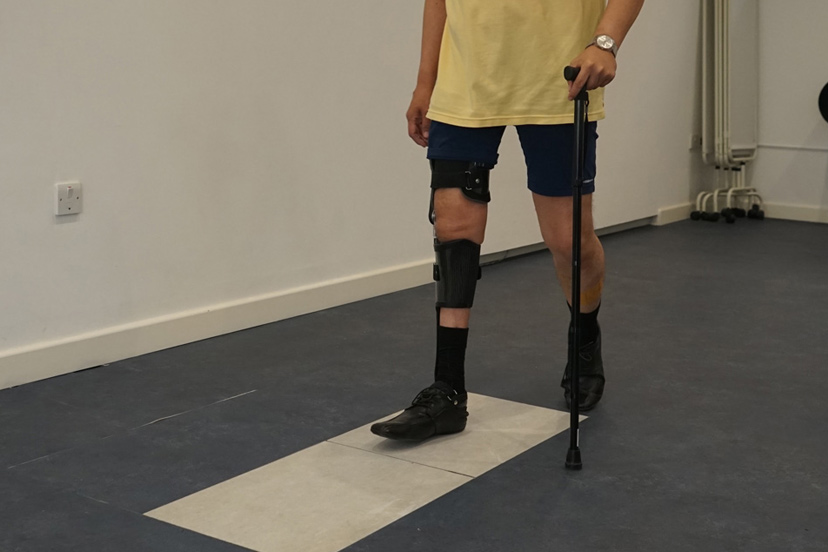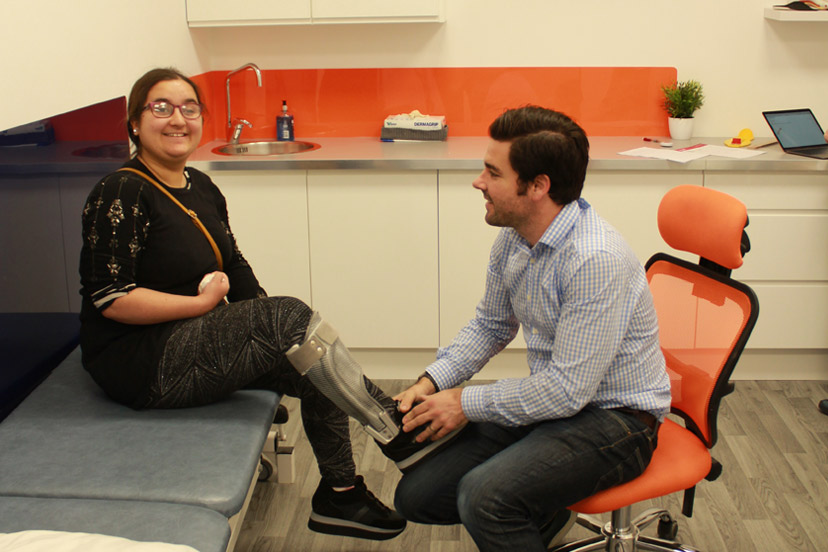Functional electronic stimulation (FES) uses the body’s existing nerves and muscles to create a desired contraction in the targeted muscle. Patients who have had an upper motor neurone injury, caused by stroke or cerebral palsy, can usually benefit.
FES works by sending an electrical impulse, either along a nerve that is located close to the surface of the skin, or through a muscle. When the impulse is passed through the muscle it causes a contraction. The big advantage of FES is that it uses the body’s existing muscular system to cause movement and control it; this means that an individual’s muscle strength can be increased or, at least, maintained.
There are also possible benefits to the sensory system. There is some evidence to suggest that FES can assist remyelination in conditions such as multiple sclerosis, or that it improves control by sending signals to the brain. Research is being carried out to validate this.

Above: Patient being assessed upon a pressure sensor within LOC's Gait Lab
At the initial consultation, an in-depth history of a patient’s neurological condition will be established. Range of movement, alignment and existing muscle power will be analysed while video gait analysis will study any areas of weakness in slow motion.
If a LOC clinician considers that an individual’s condition is appropriate for FES, then we will test the MyGait system. This involves applying electrodes to targeted areas of the body in order to create the desired muscle contractions. As anatomy can vary between individuals finding the perfect position for the electrodes can take some time. Your clinician will then test the signal from the electrodes and fine-tune the type of muscle contraction that is required.
Once that has been successful, your clinician will use the system while you are walking. MyGait has very sophisticated software that allows fine-tuning of both the timing and strength of the impulses wirelessly as the patient walks. It is possible to see immediate and remarkable improvements.

We have the following facilities and amenities at our Kingston Upon Thames location:
We also have the Gait Laboratory for orthotics patients and Onsite Manufacturing for speedy turnarounds and adjustments whilst you wait.
An insole is a contoured orthotic device which alters the characteristics and biomechanics of the foot and ankle area. Biomechanics are concerned with mechanical laws and how they affect the living body, especially the musculoskeletal system.
They are removable devices, often made from plastic, that are designed to fit inside a shoe to provide additional support for your feet. As well as offering shock absorption, an insole can help distribute the weight of your body more effectively across the foot and can be made bespoke to cover a range of biomechanical conditions.
If you have symptoms in your feet, ankles, hips or your lower back that are intermittent or were not there to start with in early life, and have started to cause you pain over a period of time, bespoke orthotic insoles could be an excellent option.
If you have already tried rest, icing, compression and elevation and your feet have not recovered, we recommend a biomechanical assessment to consider the possibility of insoles. They are a non-invasive approach to treatment and in many cases, are a great option for symptoms that are not severe enough to warrant surgical intervention. Alternatively, they can be considered as an option prior to surgery.
We will send patients away when an insole is not appropriate, if a patient is suffering with iliotibial band syndrome for example, the problem can be helped with physiotherapy and a stretching programme. That’s what our biomechanical assessment is all about; determining whether there would be any benefit from altering the alignment of your feet.

Join The London Orthotic Consultancy in celebrating Cerebral Palsy Awareness Day on March 25th. Learn just how important expert orthotic care is in enhancing mobility, independence, and quality of life for children and adults with cerebral palsy.

Introducing the Agilik™ smart orthosis, a cutting-edge, powered knee orthotic now available in the UK through the London Orthotic Consultancy. Unlike traditional KAFOs or heavy exoskeletons, the Agilik™ provides dynamic knee assistance and offers real-time support, reducing fatigue and improving posture. This pioneering, modern technology can help children and adults with lower limb weakness walk more efficiently and naturally. We are honoured to be selected as the exclusive paediatric specialist centre in the UK for the Agilik™ device.

When Sophie noticed her baby Max had a persistent flat spot on his head, she was told it would resolve naturally—but it didn’t. Seeking a second opinion led her to the London Orthotic Consultancy, where Max was diagnosed with severe plagiocephaly.

A little more than four years after the LOCband Lite's launch, we're proud to have successfully treated our 250th helmet therapy patient at our Romford clinic using our cutting-edge 3D-printed cranial band. After five months of treatment, her final scan showed that her asymmetry had decreased from 12 mm to 3 mm.

Sky News published an article this month quoting scientists at Southmead Hospital who claimed there was a lack of research into flat head syndrome and its treatment with cranial remoulding (helmet) therapy. This is our response.

With our non-surgical treatment plan, Alex achieved 100% chest correction in just two years. His treatment involved a combination of dynamic chest compressor and vacuum bell therapy treatment to address his pectus excavatum and rib flaring.

Learn how a custom carbon fibre AFO helped Gill regain mobility and comfort despite complex challenges from shin bone (tibia) removal. We created a truly tailored orthotic solution made from pre-preg carbon fibre at our Cambridge clinic.

Discover how bespoke orthotics and the OSKAR program with Elaine Owen transformed Archie’s life with cerebral palsy quadriplegia, helping him avoid a wheelchair and achieve greater mobility.